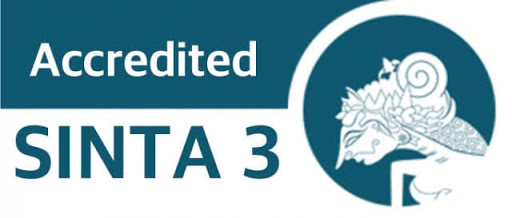INCREASING STUDENTS’ LEARNING INTEREST THROUGH BLENDED LEARNING IN THE EDUCATIONAL PSYCHOLOGY COURSE
Abstract
Education is a development, reinforcement, and improvement attempt at people’s ability and potential through teaching, guidance, example, and so on needed by themselves, other people, and nation and state. In fact, there are many students who believe that learning is not fun so their interest in learning decreases. Therefore, innovative learning is needed to increase students’ interest in learning. One of the attempts is to apply the Blended Learning model. This paper aims to determine whether there is a significant effect of blended learning on students’ learning interest in educational psychology courses. This paper is quantitative research with a causal type, which involved 43 third-semester students of the Islamic Education study program of IDIA Prenduan. Based on the findings of the data analysis tested through simple linear regression, the value of the t-count of 0.847 is smaller than t-table 2.019 at a significant level of 5%. It can be concluded that blended learning has an insignificant effect on students’ learning interest in Educational Psychology courses of the Islamic Education study program of IDIA in the academic year 2021-2022.
Keywords
Full Text:
PDF (ENGLISH)References
Abdullah, W. (2018). Model Blended Learning Dalam Meningkatkan Efektifitas Pembelajaran. FIKROTUNA: Jurnal Pendidikan Dan Manajemen Islam, 7(1), 14–22. https://doi.org/10.36987/jes.v8i2.2243
Cahyani, S., Basri, S., & Mus, S. (2022). Pembelajaran Berbasis Blended Learning di SMA Negeri 2 Soppeng. Universitas Negeri Makassar, (8.5.2017), 2003–2005.
Dakhi, O., Jama, J., Irfan, D., Ambiyar, & Ishak. (2020). Blended learning: a 21st century learning model at college. International Journal Of Multi Science, 1(7), 50–65.
Husamah. (2014). Pembelajaran Bauran (Blended Learning) ( by M. Jauhar, Ed.). Banten: Prestasi Pustakaraya.
Idris, H. (2011). Pembelajaran Model Blended Learning. Jurnal Iqra’, 5(1), 61–73. https://doi.org/10.30984/jii.v5i1.562
Imron, M. (2019). Pengaruh Biaya Pendidikan Terhadap Minat Belajar Siswa Di MTS Al-Wathan Larangan Perreng Pragaan Sumenep Tahun Pelajaran 2018/2019. Institut Dirosat Islamiyah Al-Amien Prenduan.
Indriani, D. (2019). Pengaruh Model Blended Learning Terhadap Motivasi Dan Prestasi Belajar. 3, 851–854.
Isti’anah, A. (2017). The Effect of Blended Learning to The Students ’ Achievement In Grammar Class. Indonesian Journal of English Education, 4(1), 16–30. https://doi.org/10.15408/ijee.v4i1.5697.IJEE
Istiningsih, S., & Hasbullah, H. (2015). Blended Learning, Trend Strategi Pembelajaran Masa Depan. Jurnal Elemen, 1(1), 49–56. https://doi.org/10.29408/jel.v1i1.79
Jalinus, N., Verawardina, U., & Krismadinata. (2020). Buku Model Flipped Blended Learning. Purwodadi: CV. Sarnu Untung.
Kristiawan, M., & Rahmat, N. (2018). Peningkatan Profesionalisme Guru Melalui Inovasi Pembelajaran. Jurnal Iqra’ : Kajian Ilmu Pendidikan, 3(2), 373–390.
Lisiswanti, R., Saputra, O., & Windarti, I. (2015). Peranan media dalam pembelajaran. Jurnal Kesehatan, 1, 102–105.
Menggo, S., & Darong, H. C. (2022). Blended Learning in Esl/Efl Class. LLT Journal: A Journal on Language and Language Teaching, 25(1), 132–148. https://doi.org/10.24071/llt.v25i1.4159
Miksan, A. (2018). Desain dan Evaluasi Pembelajaran Blended Learning Berbasis Whatsapp Group (WAG). Dirasah : Jurnal Studi Ilmu Dan Manajemen Pendidikan Islam, 1(1), 120–134. https://doi.org/10.29062/dirasah.v1i1.56
Munzadi, M. (2018). Pengaruh Blended Learning Berbasis Rotation Model Terhadap Motivasi Dan Hasil Belajar Geografi Siswa MA. Jurnal Pendidikan Geografi Undiksha, 6(3), 125–132.
Nasution, N., Jalinus, N., & Syahril. (n.d.). Buku Model Blended Learning. Retrieved from https://www.ptonline.com/articles/how-to-get-better-mfi-results
Nurhadi, N. (2020). Blended Learning Dan Aplikasinya Di Era New Normal Pandemi COVID-19. Jurnal Agriekstensia, 19(2).
Nurpaisah. (2021). Hubungan Penggunaan Pebelajaran Daring Dengan Minat Belajar Fisika Peserta Didik SMA Negeri 15 Wajo. Universitas Muhammadiyah Makassar.
Rahman, Z., Rijanto, T., Basuki, I., & Sumbawati, M. S. (2020). The Implementation of Blended Learning Model on Motivation and Students’ Learning Achievement. International Journal for Educational and Vocational Studies, 2(9), 767–775. https://doi.org/10.29103/ijevs.v2i9.2694
Resmiaty, T., Chaeruman, U. A., & Kusumawardani, D. (2021). The implementation of blended learning in the new normal era at vocational school of health. Jurnal Pendidikan Vokasi, 11(2), 182–191. https://doi.org/10.21831/jpv.v11i2.42495
Rizki Firmansyah. (2019). Pengaruh Blended Learning Terhadap Hasil Belajar Pai Peserta Didik Kelas X Sman 8 Bandar Lampung. Universitas Islam Negeri Raden Intan Lampung.
Rusli, M. (2013). Pedoman Praktis Membuat Proposal Dan Laporan Penelitian Lapangan. Sumenep: LP3M Paramadani.
Salsabila, R. (2022). Implementasi Sistem Pembelajaran Blended Learning di SMAS Perintis 2 Bandar Lampung. Universitas Islam Negeri Raden Intan Lampung.
Sohaya, E. M. (2019). Pemanfaatan Model Pembelajaran Blended Learning dalam Mengembangkan dan Meningkatkan Keprofesionalan Pendidik di Era Revolusi Industri 4 . 0. Prosiding Seminar Nasional Teknologi Pendidikan Pascasarjana UNIMED, 5, 584–594. Retrieved from http://digilib.unimed.ac.id/id/eprint/38852
Sugiyono. (2016). Metode Penelitian Kuantitatif, kualitatif dan R&D. Bandung: Alfabeta.
Sugiyono. (2019). Metode Penelitian Kuantitatif (Setiyawami, Ed.). Bandung: Alfabeta.
Tidjani, A., & Ardiyanti. (2021). Efektivitas PenggunaanSistem Informasi Terintegrasi (Simaster)dalam Pembelajaran Jarak Jauh (Studi Kasus PembelajaranJarak Jauh Di Fakultas Tarbiyah IDIA Prenduan. Jurnal Ilmiah AL-Jauhari: Jurnal Studi Islam Dan Interdisipliner, 6(2), 186–208. https://doi.org/10.30603/jiaj.v6i2.2090
Ulfa, M., & Puspaningtyas, N. D. (2020). The Effectiveness of Blended Learning Using A Learning System in Network (SPADA) in Understanding of Mathematical Concept. Jurnal Matematika Dan Pembelajaran, 8(1), 47–60.
Undang-undang Nasional, Sistem Pendidikan. “Introduction and Aim of the Study.” Acta Pædiatrica, vol. 71, 1982, pp. 6–6,. (n.d.).
Yuni Pratiwi, P., & Warneri. (2016). Penerapan Model Blended Learning Untuk Meningkatkan Performansi Belajar Siswa Mata Pelajaran Ekonomi Di SMA. Jurnal Pendidikan Dan Pembelajaran Khatulistiwa, 5(11).
Yustina, Syafii, W., & Vebrianto, R. (2020). The effects of blended learning and project-based learning on pre-service biology teachers’ creative thinking skills through online learning in the COVID-19 pandemic. Jurnal Pendidikan IPA Indonesia, 9(3), 408–420. https://doi.org/10.15294/jpii.v9i3.24706
Zamzami, Z., & Keumala, C. M. (2018). Blended Learning Method Within Indonesian Higher Education Institutions. Jurnal Pendidikan Humaniora, 6(2), 69–77.
DOI: http://dx.doi.org/10.33578/pjr.v7i1.9069
Refbacks
- There are currently no refbacks.
Copyright (c) 2023 JURNAL PAJAR (Pendidikan dan Pengajaran)

This work is licensed under a Creative Commons Attribution-NonCommercial-ShareAlike 4.0 International License.
JURNAL PAJAR (Pendidikan dan Pengajaran)
Secretariat
Program Studi Pendidikan Guru Sekolah Dasar
Gedung B1, FKIP Universitas Riau
Kampus Bina Widya Km. 12,5 Simpang Baru Panam
Pekanbaru Riau Indonesia 28293
e-mail : pajar@ejournal.unri.ac.id



